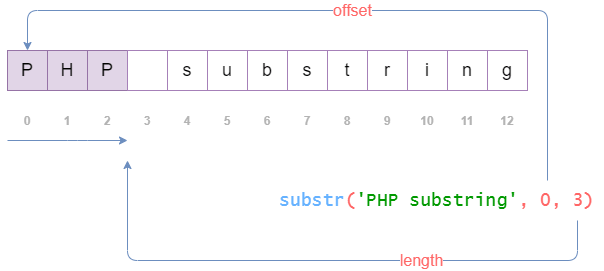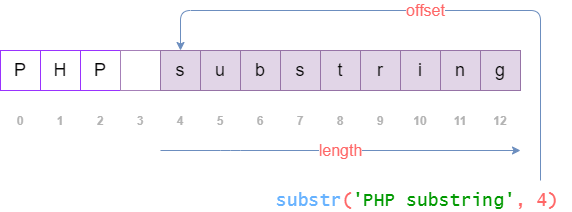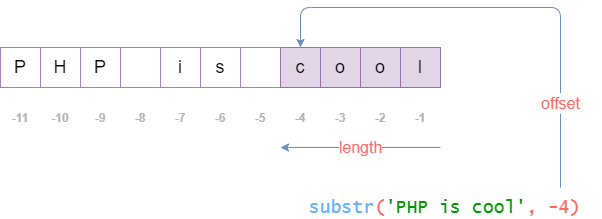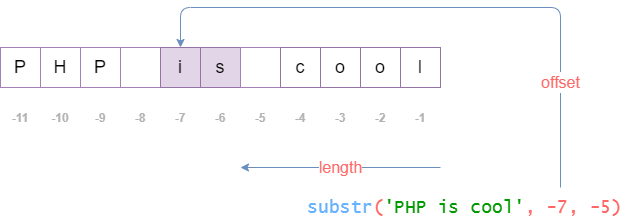Summary: in this tutorial, you’ll learn how to use the PHP substr() function to extract a substring from a string.
Introduction to the PHP substr() function #
The substr() function accepts a string and returns a substring from the string.
Here’s the syntax of the substr() function:
substr ( string $string , int $offset , int|null $length = null ) : stringCode language: PHP (php)In this syntax:
$stringis the input string.$offsetis the position at which the function begins to extract the substring.$lengthis the number of characters to include in the substring. If you omit the$lengthargument, thesubstr()function will extract a substring from the$offsetto the end of the$string. If the$lengthis 0, false, or null, thesubstr()function returns an empty string.
PHP substr() function examples #
Let’s take some examples of using the substr() function.
1) Simple PHP substr() function example #
The following example uses the substr() function to extract the first three characters from a string:
<?php
$s = 'PHP substring';
$result = substr($s, 0, 3);
echo $result;// PHPCode language: PHP (php)In this example, the substr() function extract the first 3 characters from the 'PHP substring' string starting at the index 0.

2) Using PHP substr() function with the default length argument #
The following example uses the substr() function to extract a substring from the 'PHP substring' string starting from the index 4 to the end of the string:
<?php
$s = 'PHP substring';
$result = substr($s, 4);
echo $result; // substringCode language: PHP (php)In this example, we omit the $length argument. Therefore, the substr() returns a substring, starting at index 4 to the end of the input string.

PHP substr() function with negative offset #
The $offset argument can be a negative number. If the $offset is negative, the substr() function returns a substring that starts at the offset character from the end of the string. The last character in the input string has an index of -1.
The following example illustrates how to use the substr() function with negative offset:
<?php
$s = 'PHP is cool';
$result = substr($s, -4);
echo $result; // coolCode language: PHP (php)In this example, the substr() returns a substring that at 4th character from the end of the string.
The following picture illustrates how the substr() function works in the above example:

PHP substr() function with negative length #
Like the $offset argument, the $length argument can be negative. If you pass a negative number to the $length argument, the substr() function will omit a $length number of characters in the returned substring.
The following example illustrates how to use the substr() with a negative $offset and $length arguments:
<?php
$s = 'PHP is cool';
$result = substr($s, -7, -5);
echo $result; // isCode language: PHP (php)The following picture illustrates how the above example works:

The PHP mb_substr() function #
See the following example:
<?php
$message = 'adiós';
$result = substr($message, 3, 1);
echo $result;Code language: PHP (php)This example attempts to extract a substring with one character in the $message string starting at index 3. However, it shows nothing in the output.
The reason is that the $message string contains a non-ASCII character. Therefore, the substr() function doesn’t work correctly.
To extract a substring from a string that contains a non-ASCII character, you use the mb_substr() function. The mb_substr() function is like the substr() function except that it has an additional encoding argument:
mb_substr ( string $string , int $start , int|null $length = null , string|null $encoding = null ) : stringCode language: PHP (php)The following example uses the mb_substr() function to extract a substring from a string with non-ASCII code:
<?php
$message = 'adiós';
$result = mb_substr($message, 3, 1);
echo $result;Code language: PHP (php)Output:
óCode language: PHP (php)PHP substr helper function #
The following defines a helper function that uses the mb_substr() function to extract a substring from a string:
<?php
function substring($string, $start, $length = null)
{
return mb_substr($string, $start, $length, 'UTF-8');
}Code language: PHP (php)Summary #
- Use the PHP
substr()function to extract a substring from a string. - Use the negative offset to extract a substring from the end of the string. The last character in the input string has an index of
-1. - Use the negative length to omit a length number of characters in the returned substring.
- Use the PHP
mb_substr()function to extract a substring from a string with non-ASCII characters.